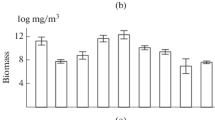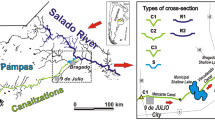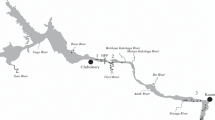Abstract
The abundance and the biodiversity of summer zooplankton in the waters of the Drawa drainage (NW Poland) were studied, as was their relation to selected environmental conditions. The conditions upstream, especially in the outlets of lakes, did not affect the zooplankton communities downstream. This was also true of tributaries which had no influence on the shape of the zooplankton communities in the main river. The number of zooplankton in the outlets of eutrophic lakes was greater than in those of mesotrophic lakes. Increased vegetation cover significantly affected mainly the crustacean communities of zooplankton. Larger amounts of zooplankton were observed in rivers where the riparian zone was not covered with vegetation, but this difference was not significant. The hydrological conditions of the rivers and the Secchi depth visibility strongly impacted the composition of the zooplankton. The influence of abiotic factors was most pronounced on the abundance of cladocerans, and least pronounced on the abundance of rotifers.
Similar content being viewed by others

References
Lair N., A review of regulation mechanisms of metazoan plankton in riverine ecosystems: aquatic habitat versus biota, River Res. Appl., 2006, 22, 567–593
Marneffe Y., Comblin S., Thomé J.P., Ecological water quality assessment of the Bütgenbach lake (Belgium) and its impact on the River Warche using rotifers as bioindicators, Hydrobiologia, 1998, 387/388, 459–467
Kobayashi T., Shiel R.J., Gibbs P., Dixon P.I., Freshwater zooplankton in the Hawkesbury-Nepean River: comparison of community structure with other rivers, Hydrobiologia, 1998, 377, 133–145
Nielsen D.L., Watson G., The response of epibenthic rotifers and microcrustacean communities to flow manipulations in lowland rivers, Hydrobiologia, 2008, 603, 117–128
Chang K.H., Doi H., Imai H., Gunji F., Nakano S.I., Longitudinal changes in zooplankton distribution below a reservoir outfall with reference to river planktivory, Limnology, 2008, 9, 125–133
Walks D.J, Cyr M., Movement of plankton through lake-stream systems, Freshwater Biol., 2004, 49, 745–759
Armitage P.D., Capper M.H., The numbers, biomass and transport downstream of micro-crustaceans and Hydra from Cow Green Reservoir (Upper Teesdale), Freshwater Biol., 1976, 6, 425–432
Czerniawski R., Domagała J., Similarities in zooplankton community between River Drawa and its two tributaries (Polish part of River Odra), Hydrobiologia, 2010, 638, 137–149
Czerniawski R., Domagała J., Zooplankton communities of two lake outlets in relation to abiotic factors, Cent. Eur. J. Biol., 2010, 5, 240–255
Karabin A., Pelagic zooplankton (Rotatoria + Crustacea) variation in the process of Lake Eutrophication. I. Structural and quantitative features, Pol. J. Ecol., 1985, 33, 567–616
Estlander S., Nurminen L., Olin M., Vinni M., Horppila J., Seasonal fluctuations in macrophyte cover and water transparency of four brown-water lakes: implications for crustacean zooplankton in littoral and pelagic habitats, Hydrobiologia, 2009, 620, 109–120
Dodson S.I., Newman A.L., Will-Wolf S., Alexander M.L., Woodford M.P., Van Egeren S., The relationship between zooplankton community structure and lake characteristics in temperate lakes (Northern Wisconsin, USA), J. Plankton Res., 2009, 31, 93–100
Kuczyńska-Kippen N., Nagengast B., The influence of the spatial structure of hydromacrophytes and differentiating habitat on the structure of rotifer and cladoceran communities, Hydrobiologia, 2006, 559, 203–212
Basu B.K., Pick F.R., Factors regulating phytoplankton and zooplankton biomass in temperate rivers, Limnol. Oceanogr., 1996, 41, 1572–1577
Nielsen D., Watson G., Petrie R., Microfaunal communities in three lowland rivers under differing regimes, Hydrobiologia, 2005, 543, 101–111
Nielsen D.L., Gigney H., Watson G., Riverine habitat heterogeneity: the role of slackwaters in providing hydrologic buffers for benthic microfauna, Hydrobiologia, 2010, 638, 181–191
Jeppesen E., Jensen J.P., Sondergaard M., Lauridsen T., Pedersen L.J., Jensen L., Top-down control in freshwater lakes: the role of nutrient state, submerged macrophytes and water depth, Hydrobiologia, 1997, 342/343, 151–164
Schiemer F., Die Bedeutung von. Augewässern als Schutzzonen für die Fischfauna, Österr. Wasserwirtsch., 1985, 37, 239–245, (in German)
Bretschko G., River/land ecotones: scales and patterns, Hydrobiologia, 1995, 303, 83–91
Wagler E., Klasse: Crustacea, Krebstiere, Die Tierwelt Mitteleuropas, II, 2a, Leipzig, 1937,(in German)
Kutikova L.A., Kolovratki fauna SSSR, Nauka, Leningrad, 1970,(in Russian)
Harding J.P., Smith W.A., A key to the British freshwater cyclopid and calanoid copepods, FBA Special Publication, Freshwater Biological Association, Far Sawrey, Cumbria, 1974
Carlson R.E., A trophic state index for lakes, Limnol. Oceanogr., 1977, 22, 361–369
Ejsmont-Karabin J., Kruk M., Effects of contrasting land use on free-swimming rotifer communities of streams in Masurian Lake District, Poland, Hydrobiologia, 1998, 387/388, 241–249
Jack J.D., Thorp J.H., Impacts of fish predation on an Ohio river zooplankton community, J. Plankton Res., 2002, 24, 119–127
Wissel B., Benndorf J., Contrasting effects of the invertebrate predator Chauborus obscuripes and planktivorous fish on plankton communities of a long-term biomanipulation experiment, Arch. Hydrobiol. 1998, 129–146
Gliwicz Z.M., Szymańska E., Wrzosek D., Body size distribution in Daphnia populations as an effect of prey selectivity by planktivorous fish, Hydrobiologia, 2010, 634, 5–19
Cromel F.H.J., Carpenter S.M., Plankton community cycling and recovery after drought — dynamics in a basin on a flood plain, Hydrobiologia, 1988, 164, 193–211
Hillbricht-Ilkowska A., Shallow lakes in lowland river systems: Role in transport and transformations of nutrients and in biological diversity, Hydrobiologia, 1999, 408/409, 349–358
Ejsmont-Karabin J., Węgleńska T., Changes in the zooplankton structure in the transitory river-lakeriver zone. The River Krutynia system, Mazurian Lake District, Zesz. Nauk. Kom. „Człowiek i Środowisko“, 1996, 13, 263–289, (in Polish)
Gliwicz Z.M., Predation or food limitation: an ultimate reason for extinction of planktonic cladoceran species, Ergebnisse der Limnologie, 1985, 21, 419–430
O’Brien W.J., Planktivory by freshwater fish: thrust and parry in the pelagial, In: Kerfoot W.C., Sih A., (Eds.), Predation. Direct and Indirect Impacts on Aquatic Communities, University Press of New England, Hanover and London, 1987
Manatunge J., Asaeda T., Priyadarshana T., The Influence of Structural Complexity on Fish-zooplankton Interactions: A Study Using Artificial Submerged Macrophytes, Environ. Biol. Fish., 2000, 58, 425–438
Richardson W.B., Microcrustacea in flowing water: experimental analysis of washout times & a field test, Freshwater Biol., 1992, 28, 217–230
Gergel S.E., Turner M.G., Kratz T.K., Scaledependent landscape effects on north temperate lakes and rivers, Ecol. Appl., 1999, 9, 1377–1390
Campbell C.E., Rainfall events and downstream drift of microcrustacean zooplankton in a Newfoundland boreal stream, Can. J. Zool., 2002, 80, 997–1003
Jones E.B.D., Helfman G.S., Harper J.O., Bolstad P.V., Effects of riparian forest removal on fish assemblages in southern Appalachian streams, Conserv. Biol., 1999, 13, 1454–1465
Dodson, S.I., Lillie R.A., Will-Wolf S., Land use, water chemistry, aquatic vegetation, and zooplankton community structure of shallow lakes, Ecol. Appl., 2005, 15, 1191–1198
Xu F.L., Tao S., Xu Z.R., The restoration of riparian wetlands and macrophytes in Lake Chao, an eutrophic Chinese lake: Possibilities and effects, Hydrobiologia, 1999, 405, 169–178
Author information
Authors and Affiliations
Corresponding author
About this article
Cite this article
Czerniawski, R., Pilecka-Rapacz, M. Summer zooplankton in small rivers in relation to selected conditions. cent.eur.j.biol. 6, 659–674 (2011). https://doi.org/10.2478/s11535-011-0024-x
Received:
Accepted:
Published:
Issue Date:
DOI: https://doi.org/10.2478/s11535-011-0024-x



